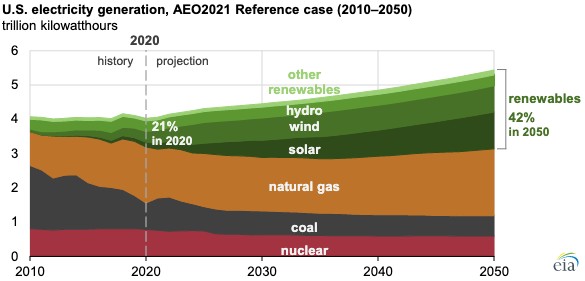
By 2030, renewables will collectively surpass natural gas to be the predominant source of electricity generation in the US, according to the US Energy Information Administration’s (EIA) Annual Energy Outlook 2021. But that’s not enough.
The EIA also projects that the share of renewables in the US electricity generation mix will double from 21% in 2020 to 42% in 2050. This is due to regulatory and market factors. Wind and solar will make up the bulk of that growth, as per the EIA chart below:

The EIA predicts that all solar electric generation (that’s photovoltaic and thermal technologies and both small-scale and utility-scale installations) will surpass wind by 2040 as the largest source of US renewable generation. However, wind will lead renewable growth through 2024, accounting for two-thirds of the increase in that period. Further, the EIA writes:
After the production tax credit (PTC) for wind phases out at the end of 2024, solar generation will account for almost 80% of the increase in renewable generation through 2050. EIA assumes that utility-scale (and commercial) solar PV facilities will receive a 30% investment tax credit (ITC) through 2023, which will then be reduced to 10% beginning in 2024 and lasts through 2050. Residential solar PV will also receive a 30% ITC through 2023, which will expire in 2024.
Natural gas, a fossil fuel, is anticipated to remain relatively constant, at about one-third of total generation from 2020 to 2050, and nuclear and coal are projected to decrease.
The EIA has made its renewable and natural gas predictions based on renewable energy technology costs and natural gas prices.
Electrek’s Take
It’s good that green energy is going to double, but it’s not good enough growth, if EIA predictions are accurate. Renewables need to make up much more than 42% of electricity generation overall by 2050. By 2035, 90% of the United States could be powered by renewables, according to a UC Berkeley study.
Plus, it’s not quite clear where the EIA is getting its ITC predictions, but its prediction appears to boost the current situation. In December, Solar Power World noted the current status of solar tax credits:
For projects on which construction began in 2019, taxpayers may claim a Solar ITC of 30% of the eligible basis of property included in the project. This phases down to 26% for projects on which construction begins in 2020, 22% for projects on which construction begins in 2021, and 10% thereafter.
The solar industry wants Congress to extend solar tax credits by five years at the original 30% level. But solar industry publications all state that what’s coming for solar, ITC-wise, is uncertain, so here’s hoping the Biden administration is as ambitious as it says it’s going to be in its support for both wind and solar.
Subscribe to Electrek on YouTube for exclusive videos and subscribe to the podcast.
Author: Michelle Lewis
Source: Electrek



